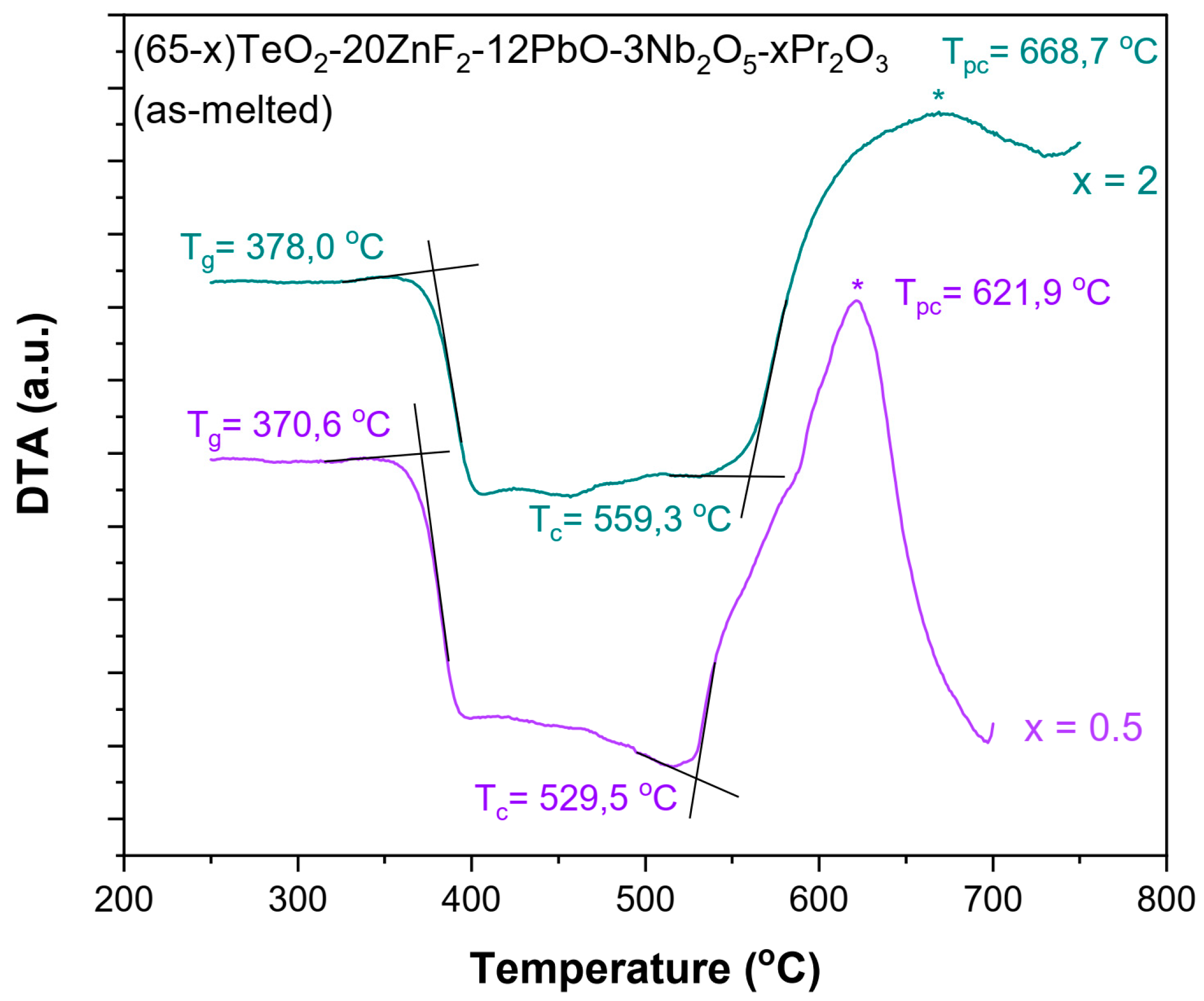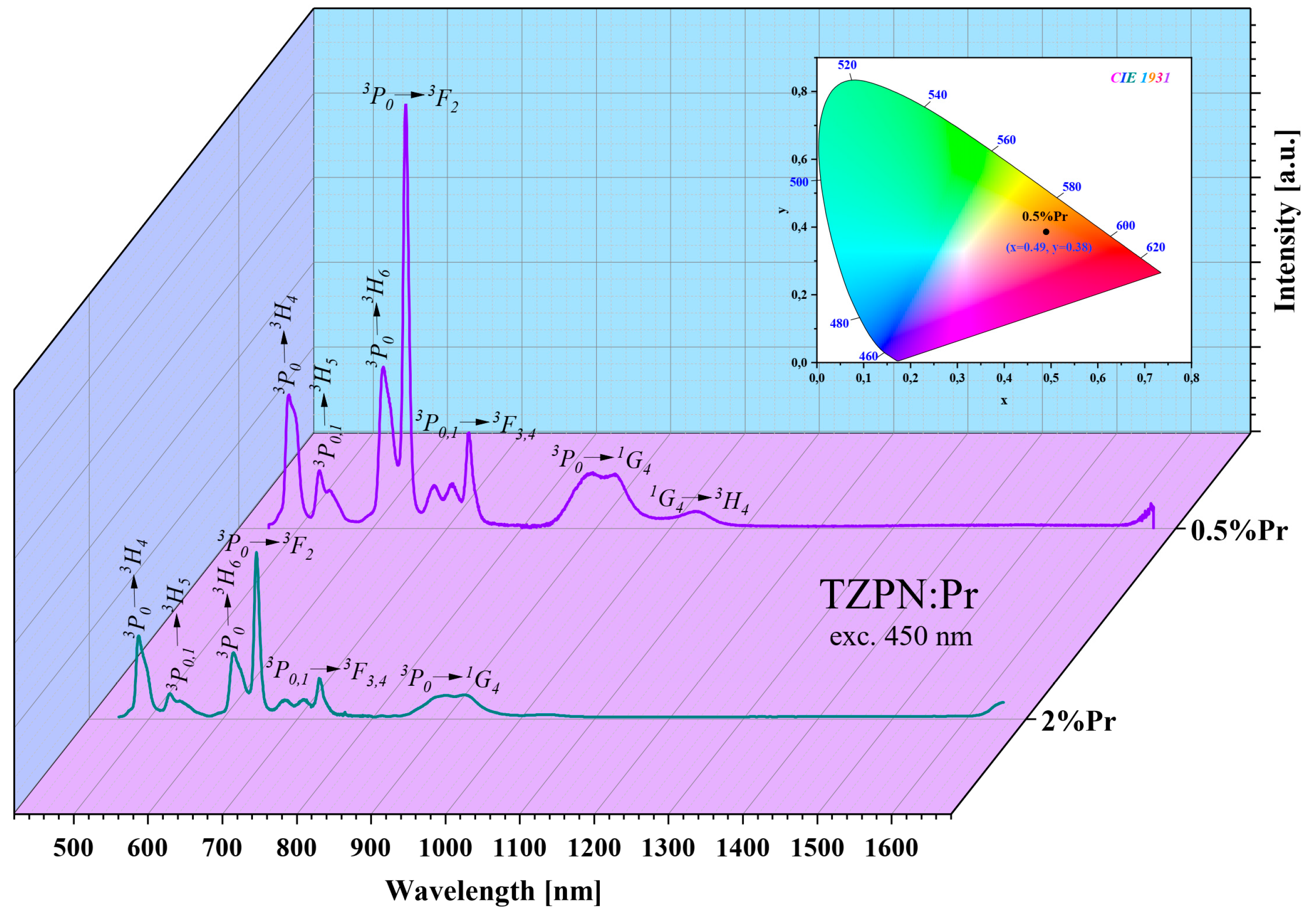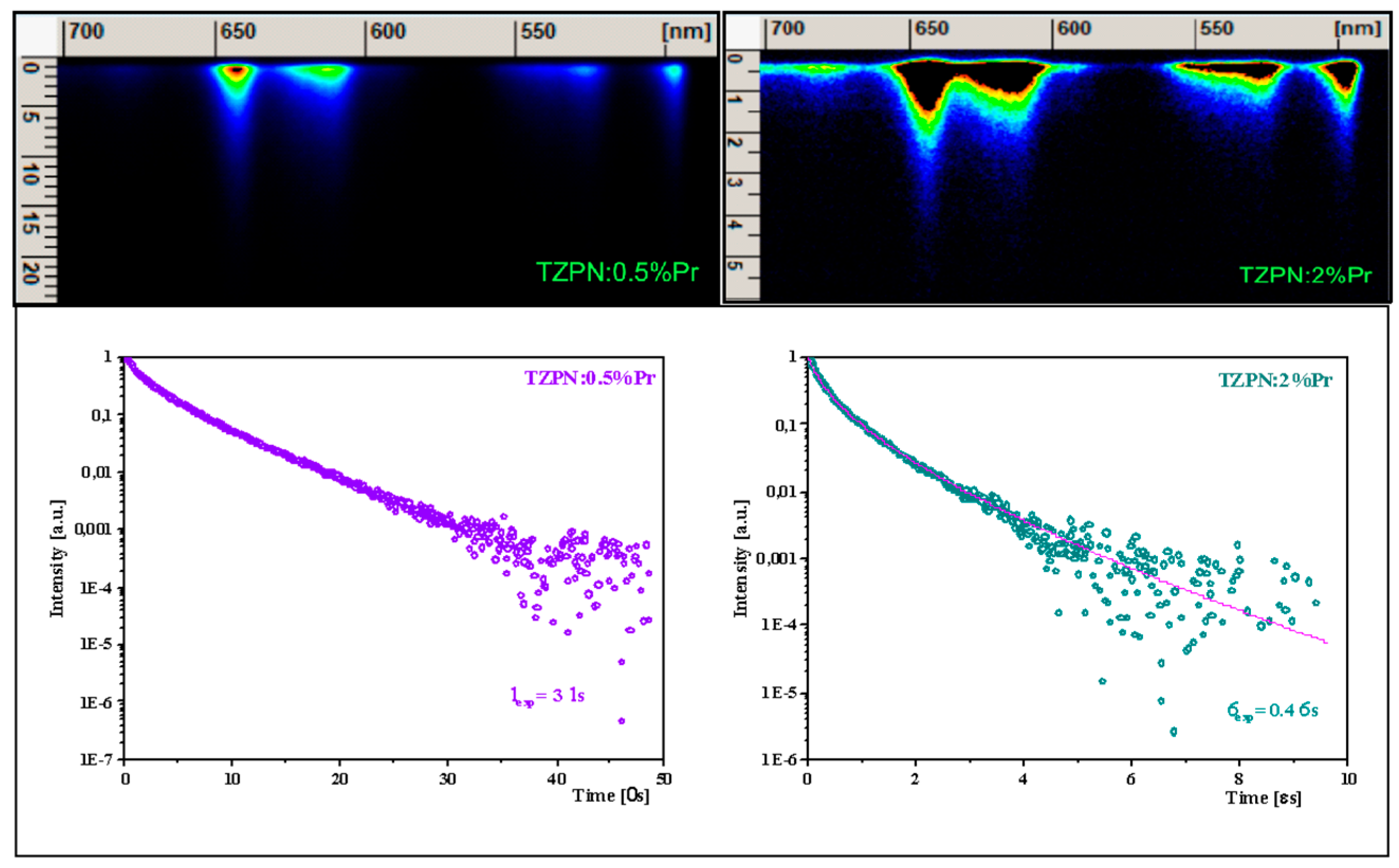Spectroscopic and Thermographic Qualities of Praseodymium-Doped Oxyfluorotellurite Glasses
Abstract
1. Introduction
2. Results and Discussion
2.1. Thermal Features
2.2. Absorption Spectra and Modified Judd–Ofelt Analysis
2.3. Emission Spectra, Radiative Properties and Color Perception
2.4. Photoluminescence Decay Analysis
2.5. Temperature Sensor Applications
3. Materials and Methods
4. Conclusions
Author Contributions
Funding
Institutional Review Board Statement
Informed Consent Statement
Data Availability Statement
Conflicts of Interest
References
- Arshad, M.; Saqib, N.U.; Rooh, G.; Chanithima, N.; Zaman, F.; Asif, M.; Kim, H.J.; Kothan, S.; Haq, S.U.; Kaewkhao, J. Spectroscopic and photoluminescence properties of praseodymium doped potassium aluminum phosphate (P2O5-K2O-Al2O3) glasses for optoelectronics applications. J. Non-Cryst. Solids 2022, 586, 121570. [Google Scholar] [CrossRef]
- Mao, S.; Ta, C.; Wen, H.; Talewar, R.A. Talewar, Optical properties of 40ZnO-40P2O5-x(10Li2O-10Nb2O5-0.2Pr3+) glass. Results Opt. 2023, 12, 100429. [Google Scholar] [CrossRef]
- Wantana, N.; Kaewnuam, E.; Chanthima, N.; Kim, H.J.; Kaewkhao, J. Tuneable luminescence of Pr3+-doped sodium aluminium gadolinium phosphate glasses for photonics applications. Optik 2022, 267, 169668. [Google Scholar] [CrossRef]
- Nazabal, V.; Adam, J. (INVITED) Infrared luminescence of chalcogenide glasses doped with rare earth ions and their potential applications. Opt. Mater. X. 2022, 15, 100168. [Google Scholar] [CrossRef]
- Kolavekar, S.B.; Ayachit, N.H. Synthesis of praseodymium trioxide doped lead-boro-tellurite glasses and their optical and physical properties. J. Mater. 2019, 5, 455–462. [Google Scholar] [CrossRef]
- Zhang, F.; Bi, Z.; Huang, A.; Xiao, Z. Luminescence and Judd–Ofelt analysis of the Pr3+ doped fluorotellurite glass. J. Lumin. 2015, 160, 85–89. [Google Scholar] [CrossRef]
- Nazabal, V.; Poulain, M.; Olivier, M.; Pirasteh, P.; Camy, P.; Doualan, D.-L.; Guy, S.; Djouama, T.; Boutarfaia, A.; Adam, J.L. Fluoride and oxyfluoride glasses for optical applications. J. Fluor. Chem. 2012, 134, 18–23. [Google Scholar] [CrossRef]
- Liao, G.; Chen, Q.; Xing, J.; Gebavi, H.; Milanese, D.; Fokine, M.; Ferraris, M. Preparation and characterization of new fluorotellurite glasses for photonics application. J. Non-Cryst. Solids 2019, 355, 447–452. [Google Scholar] [CrossRef]
- El-Okr, M.; Ibrahem, M.; Farouk, M. Structure and properties of rare-earth-doped glassy systems. J. Phys. Chem. Solids 2008, 69, 2564–2567. [Google Scholar] [CrossRef]
- Maheshwari, K.; Aman Prasad, R.; Tayal, Y.; Rao, A.S. Spectroscopic studies of Pr3+ doped red-emitting BaO–ZnO–Li2O–P2O5 glasses for luminescent devices applications. Opt. Mater. 2023, 140, 113910. [Google Scholar] [CrossRef]
- de Araújo, C.B.; Kassab, L.R.; da Silva, D.M. Optical properties of glasses and glass-ceramics for optical amplifiers, photovoltaic devices, color displays, optical limiters, and Random Lasers. Opt. Mater. 2022, 131, 112648. [Google Scholar] [CrossRef]
- Tanaka, H.; Kalusniak, S.; Badtke, M.; Demesh, M.; Kuleshov, N.V.; Kannari, F.; Kränkel, C. Visible solid-state lasers based on Pr3+ and Tb3+. Prog. Quantum Electron. 2022, 84, 100411. [Google Scholar] [CrossRef]
- Kumar, M.; Vijayalakshmi, R.P.; Ratnakaram, Y.C. Investigation of structural and optical properties of Pr3+ doped and Pr3+/Dy3+ co-doped multicomponent bismuth phosphate glasses for visible light applications. J. Mol. Struct. 2022, 1265, 133333. [Google Scholar] [CrossRef]
- Bian, Z.P.; Li, D.S.; Zhao, X.; Lin, H. Multi-peak emissions of Pr3+-doped heavy metal tellurite glasses for laser-driven illumination. Radiat. Phys. Chem. 2018, 151, 126–132. [Google Scholar] [CrossRef]
- Belançon, M.P.; Marconi, J.D.; Ando, M.F.; Barbosa, L.C. Near-IR emission in Pr3+ single doped and tunable near-IR emission in Pr3+/Yb3+ codoped tellurite tungstate glasses for broadband optical amplifiers. Opt. Mater. 2014, 36, 1020–1026. [Google Scholar] [CrossRef]
- Jacquier, B.; Lebrasseur, E.; Guy, S.; Belarouci, A.; Menchini, F. Rare earth-doped confined structures for amplifiers and lasers. J. Alloys Compd. 2000, 303–304, 207–213. [Google Scholar] [CrossRef]
- Kwaśny, M.; Mierczyk, Z.; Stȩpień, R.; Jȩdrzejewski, K. Nd3+-, Er3+- and Pr3+-doped fluoride glasses for laser applications. J. Alloys Compd. 2000, 300–301, 341–347. [Google Scholar] [CrossRef]
- Kumar Rai, V.; Rai, D.K.; Rai, S.B. Pr3+ doped lithium tellurite glass as a temperature sensor. Sens. Actuators A Phys. 2006, 128, 14–17. [Google Scholar] [CrossRef]
- Kumar Rai, V.; Kumar, K.; Rai, S.B. Upconversion in Pr3+ doped tellurite glass. Opt. Mater. 2007, 29, 873–878. [Google Scholar] [CrossRef]
- Lalla, E.A.; Konstantinidis, M.; De Souza, I.; Daly, M.G.; Martín, I.R.; Lavín, V.; Rodríguez-Mendoza, U.R. Judd-Ofelt parameters of RE3+-doped fluorotellurite glass (RE3+= Pr3+, Nd3+, Sm3+, Tb3+, Dy3+, Ho3+, Er3+, and Tm3+). J. Alloys Compd. 2020, 845, 156028. [Google Scholar] [CrossRef]
- Algarni, H.; Reben, M.; Yousef, E. Optical features of novel fluorotellurite glasses based on TeO2- LiNbO3- BaF2- La2O3- (Nb2O5 or TiO2). Optik 2018, 156, 720–727. [Google Scholar] [CrossRef]
- Génova, R.T.; Martín, I.R.; Rodríguez-Mendoza, U.R.; Lahoz, F.; Lozano-Gorrín, A.D.; Núñez, P.; González-Platas, J.; Lavín, V. Optical intensities of Pr3+ ions in transparent oxyfluoride glass and glass–ceramic. Applications of the standard and modified Judd–Ofelt theories. J. Alloys Compd. 2004, 380, 167–172. [Google Scholar] [CrossRef]
- Xu, J.; Guyot, Y.; Lebbou, K.; Xu, X.; Liu, J.; Xu, J.; Moncorgé, R. Luminescence properties of Pr3+ doped Bi4Ge3O12 crystal fibers grown by the micro-pulling down technique. J. Lumin. 2023, 260, 119882. [Google Scholar] [CrossRef]
- Macalik, B.; Lisiecki, R.; Kowalski, R.M.; Ryba-Romanowski, W. Down- and up-conversion of femtosecond light pulses into Pr3+ luminescence in LiTaO3:Pr3+ single crystal. J. Lumin. 2020, 224, 117294. [Google Scholar] [CrossRef]
- Kowalczyk, M.; Kaczkan, M.; Majchrowski, A.; Malinowski, M. Spectroscopic characterization of orthorhombic δ-BiB3O6 phase nonlinear single crystal doped with Pr3+ ions. J. Lumin. 2019, 207, 251–257. [Google Scholar] [CrossRef]
- Liu, J.; Chen, S.; Han, L.; Liu, C.; You, W.; Ye, X.; Zhang, L. Composition dependence visible fluorescence from praseodymium ions doped Al2O3–CaO-M(M=B2O3, GeO2, Ga2O3) glasses. Phys. B 2023, 658, 414842. [Google Scholar] [CrossRef]
- Himamaheswara Rao, V.; Syam Prasad, P.; Sowri Babu, K. Visible luminescence characteristics of Pr3+ ions in TeO2–Sb2O3–WO3 glasses. Opt. Mater. 2020, 101, 109740. [Google Scholar] [CrossRef]
- Jamalaiah, B.C.; Viswanadha, G.; Venkata Rao, K. Rich reddish-orange emitting PBTNAPr glasses for laser applications. Opt. Mater. 2019, 96, 109340. [Google Scholar] [CrossRef]
- Yang, J.; Shen, L.; Yue, E.; Pun, B.; Lin, H. Superiority of shortwave transparent glasses with moderate phonon energy in achieving effective radiations from 1D2 level of Pr3+. J. Lumin. 2019, 213, 51–60. [Google Scholar] [CrossRef]
- Wold, A. Chemistry of glasses. Mater. Res. Bull. 1991, 26, 836–837. [Google Scholar] [CrossRef]
- Klimesz, B.; Lisiecki, R.; Ryba-Romanowski, W. Oxyfluorotellurite glasses doped with neodymium and ytterbium-thermal and spectroscopic properties as well as energy transfer phenomena. J. Lumin. 2018, 199, 310–318. [Google Scholar] [CrossRef]
- Ramakrishna, P.; Padhi, R.; Parida, S.K.; Mohapatra, D.; Jena, H.; Panigrahi, B. Effect of U on the photoluminescence of Pr and structural properties of U/Pr doped and co-doped Li2O–ZnO–SrO borophosphate glass. Opt. Mater. 2022, 134, 113121. [Google Scholar] [CrossRef]
- Mohamed, N.; Hassan, J.; Matori, K.M.; Azis, R.S.; Wahab, Z.A.; Ismail, Z.M.M.; Baharuddin, N.; Rashid, S.S.A. Influence of Pr doping on the thermal, structural and optical properties of novel SLS-ZnO glasses for red phosphor. Results Phys. 2017, 7, 1202–1206. [Google Scholar] [CrossRef]
- Vighnesh, K.R.; Ramya, B.; Nimitha, S.; Wagh, A.; Sayyed, M.I.; Sakar, E.; Yakout, H.A.; Dahshan, A.; Kamath, S.D. Structural, optical, thermal, mechanical, morphological & radiation shielding parameters of Pr3+ doped ZAlFB glass systems. Opt. Mater. 2020, 99, 109512. [Google Scholar] [CrossRef]
- Saad, M.; Poulain, M. Glass Forming Ability Criterion. Mater. Sci. Forum. 1987, 19–20, 11–18. [Google Scholar] [CrossRef]
- Klimesz, B.; Lisiecki, R.; Ryba-Romanowski, W. Oxyfluorotellurite glasses doped by dysprosium ions. Thermal and optical properties. Opt. Mater. 2015, 42, 538–543. [Google Scholar] [CrossRef]
- Judd, B.R. Optical Absorption Intensities of Rare-Earth Ions. Phys. Rev. 1962, 127, 750–761. [Google Scholar] [CrossRef]
- Ofelt, G.S. Intensities of Crystal Spectra of Rare-Earth Ions. J. Chem. Phys. 1962, 37, 511–520. [Google Scholar] [CrossRef]
- Medeiros Neto, J.A.; Hewak, D.W.; Tate, H. Application of a modified Judd-Ofelt theory to praseodymium-doped fluoride glasses. J. Non-Cryst. Solids 1995, 183, 201–207. [Google Scholar] [CrossRef]
- Jose, G.; Thomas, V.; Jose, G.; Paulose, P.I.; Unnikrishnan, N.V. Application of a modified Judd–Ofelt theory to Pr3+ doped phosphate glasses and the evaluation of radiative properties. J. Non-Cryst. Solids 2003, 319, 89–94. [Google Scholar] [CrossRef]
- Kumar, M.V.V.; Gopal, K.R.; Reddy, R.R.; Reddy, G.V.L.; Hussain, N.S.; Jamalaiah, B.C. Application of modified Judd–Ofelt theory and the evaluation of radiative properties of Pr3+-doped lead telluroborate glasses for laser applications. J. Non-Cryst. Solids 2013, 364, 20–27. [Google Scholar] [CrossRef]
- Kornienko, A.A.; Kaminskii, A.A.; Dunina, E.B. Dependence of the line strength of f–f transitions on the manifold energy. II. Analysis of Pr3+ in KPrP4O12. Phys. Status Solidi B 1990, 157, 267–273. [Google Scholar] [CrossRef]
- Anjaiah, J.; Laxmikanth, C.; Veeraiah, N.; Kistaiah, P. Luminescence properties of Pr3+ doped Li2O–MO–B2O3 glasses. J. Lumin. 2015, 161, 147–153. [Google Scholar] [CrossRef]
- Hormadaly, J.; Reisfeld, R. Intensity parameters and laser analysis of Pr3+ and Dy3+ in oxide glasses. J. Non-Cryst. Solids 1979, 30, 337–348. [Google Scholar] [CrossRef]
- Man, S.Q.; Pun, E.Y.B.; Chung, P.S. Tellurite glasses for 1.3 μm optical amplifiers. Opt. Commun. 1999, 168, 369–373. [Google Scholar] [CrossRef]
- Kumar Rai, V.; Rai, S.B.; Rai, D.K. Spectroscopic properties of Pr3+ doped in tellurite glass. Spectrochim. Acta Part A Mol. Biomol. Spectrosc. 2005, 62, 302–306. [Google Scholar] [CrossRef]
- Marek, Ł.; Sobczyk, M. Spectroscopic investigations of Pr3+ ions in Na2O-La2O3-ZnO-TeO2 glasses. J. Non-Cryst. Solids 2018, 487, 96–103. [Google Scholar] [CrossRef]
- Wei, D.; Seo, H.J.; Liu, Y.; Yang, X. Broadband infrared emission of Pr3+-doped BiLa2O4.5 phosphor for optical amplifier applications. J. Lumin. 2023, 253, 119488. [Google Scholar] [CrossRef]
- Ohishi, Y.; Kanamori, T.; Kitagawa, T.; Takahashi, T.; Snitzer, E.; Sigel, G.H. Pr3+-doped fluoride fiber amplifier operating at 1.31 μm. Opt. Lett. 1991, 16, 1747–1749. [Google Scholar] [CrossRef]
- McCamy, C.S. Correlated color temperature as an explicit function of chromaticity coordinates. Color. Res. Appl. 1992, 17, 142–144. [Google Scholar] [CrossRef]
- Mariselvam, K.; Liu, J. Investigations on the luminescence and gamma ray shielding features of Pr3+: BLCZFB glass for orange-red laser and radiation applications. Phys. B 2021, 614, 413024. [Google Scholar] [CrossRef]
- Komal Poojha, M.K.; Naseer, K.A.; Matheswaran, P.; Marimuthu, K.; El Shiekh, E. Effect of alkali/alkaline modifiers on Pr3+ ions doped lead boro-tellurite glasses for lasing material applications. Opt. Mater. 2023, 143, 114289. [Google Scholar] [CrossRef]
- Zatryb, G.; Klak, M. On the choice of proper average lifetime formula for an ensemble of emitters showing non-single exponential photoluminescence decay. J. Phys. Condens. Matter 2020, 32, 415902. [Google Scholar] [CrossRef] [PubMed]
- Prasad, R.N.A.; Siva, B.V.; Neeraja, K.; Mohan, N.K.; Rojas, J.I. Effect of modifier oxides on spectroscopic and optical properties of Pr3+ doped PbO–Ro2O3–WO3–B2O3 glasses (with Ro2O = Sb2O3, Al2O3, and Bi2O3). J. Lumin. 2021, 230, 117666. [Google Scholar] [CrossRef]
- Inokuti, M.; Hirayama, F. Influence of Energy Transfer by the Exchange Mechanism on Donor Luminescence. J. Chem. Phys. 1965, 43, 1978. [Google Scholar] [CrossRef]
- Rao, A.A.S. Luminescence and optical thermometry strategy based on emission spectra of Li2Ba5W3O15:Pr3+ phosphors. Opt. Mater. 2023, 145, 114476. [Google Scholar] [CrossRef]
- Wang, J.; Chen, N.; Li, J.; Feng, Q.; Lei, R.; Wang, H.; Xu, S. A novel high-sensitive optical thermometer based on the multi-color emission in Pr3+ doped LiLaMgWO6 phosphors. J. Lumin. 2021, 238, 118240. [Google Scholar] [CrossRef]






| Transition 3H4→ | Energy ν [cm−1] | Oscillator Strengths P × 10−6 | |
|---|---|---|---|
| Pexp | P′cal | ||
| 3H6, 3F2 | 5133 | 9.74 | 9.72 |
| 3F3, 3F4 | 6595 | 20.44 | 20.70 |
| 1G4 | 9851 | 0.57 | 0.70 |
| 1D2 | 16,882 | 4.78 | 2.91 |
| 3P0, 3P1, 1I6, 3P2 | 21,773 | 39.55 | 39.55 |
| SLJ | S′L′J′ | Average Wavelength [μm] | Wr [s−1] | β | τrad [μs] |
|---|---|---|---|---|---|
| 1G4 | 3H4 | 1.037 | 209.43 | 1.0000 | 4774.78 |
| 3H5 | 1.327 | 0.00 | 0.0000 | ||
| 3H6 | 1.868 | 0.00 | 0.0000 | ||
| 3F2 | 2.124 | 0.00 | 0.0000 | ||
| 3F3,4 | 3.082 | 0.00 | 0.0000 | ||
| 1D2 | 3H4 | 0.600 | 4124.10 | 0.2521 | 61.13 |
| 3H5 | 0.687 | 101.56 | 0.0062 | ||
| 3H6 | 0.808 | 2083.52 | 0.1274 | ||
| 3F2 | 0.853 | 2324.58 | 0.1421 | ||
| 3F3,4 | 0.974 | 7724.73 | 0.4722 | ||
| 1G4 | 1.427 | 0.00 | 0.0000 | ||
| 3P0 | 3H4 | 0.489 | 110,347.25 | 0.5309 | 4.81 |
| 3H5 | 0.545 | 0.00 | 0.0000 | ||
| 3H6 | 0.619 | 17,288.85 | 0.0832 | ||
| 3F2 | 0.645 | 57,824.60 | 0.2782 | ||
| 3F3,4 | 0.711 | 22,341.41 | 0.1075 | ||
| 1G4 | 0.927 | 0.00 | 0.0000 | ||
| 1D2 | 2.661 | 42.36 | 0.0002 |
Disclaimer/Publisher’s Note: The statements, opinions and data contained in all publications are solely those of the individual author(s) and contributor(s) and not of MDPI and/or the editor(s). MDPI and/or the editor(s) disclaim responsibility for any injury to people or property resulting from any ideas, methods, instructions or products referred to in the content. |
© 2024 by the authors. Licensee MDPI, Basel, Switzerland. This article is an open access article distributed under the terms and conditions of the Creative Commons Attribution (CC BY) license (https://creativecommons.org/licenses/by/4.0/).
Share and Cite
Klimesz, B.; Ryba-Romanowski, W.; Lisiecki, R. Spectroscopic and Thermographic Qualities of Praseodymium-Doped Oxyfluorotellurite Glasses. Molecules 2024, 29, 3041. https://doi.org/10.3390/molecules29133041
Klimesz B, Ryba-Romanowski W, Lisiecki R. Spectroscopic and Thermographic Qualities of Praseodymium-Doped Oxyfluorotellurite Glasses. Molecules. 2024; 29(13):3041. https://doi.org/10.3390/molecules29133041
Chicago/Turabian StyleKlimesz, Barbara, Witold Ryba-Romanowski, and Radosław Lisiecki. 2024. "Spectroscopic and Thermographic Qualities of Praseodymium-Doped Oxyfluorotellurite Glasses" Molecules 29, no. 13: 3041. https://doi.org/10.3390/molecules29133041
APA StyleKlimesz, B., Ryba-Romanowski, W., & Lisiecki, R. (2024). Spectroscopic and Thermographic Qualities of Praseodymium-Doped Oxyfluorotellurite Glasses. Molecules, 29(13), 3041. https://doi.org/10.3390/molecules29133041







